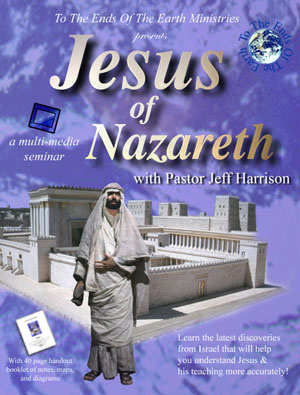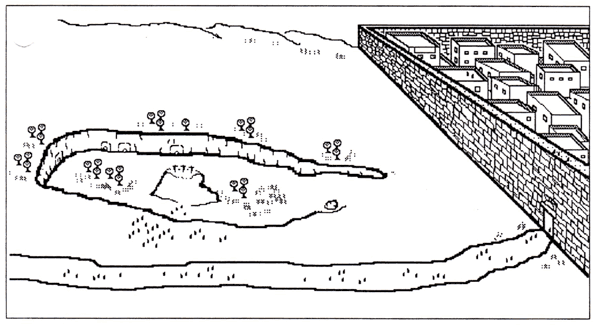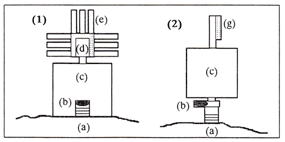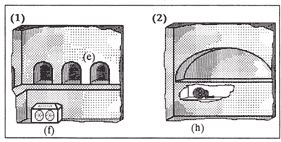Jesus of Nazareth
—A Landmarks of Faith Seminar—

Lecture #5b Audio
Jesus’ Passion and Triumph
 See notes below. (Sections in parentheses are covered in the longer form of this seminar and in a coming book version.)
See notes below. (Sections in parentheses are covered in the longer form of this seminar and in a coming book version.)Lecture #5b:
Or click here for more listening options at Internet Archive.
__________________________
Lecture #5b Notes
PASSOVER MEAL (Continued)
Foods we know were on the table in Jesus’ day: 1) Unleavened bread, 2) bitter herbs, 3) wine, 4) lamb stew
Haroseth: A brown apple puree. A symbol of the mud used to make bricks in Egypt.
Sop: The piece of bread that Jesus dipped and gave to Judas (in the King James Version, John 13:26).
Main meal
Aphikomen: a piece of bread, the last thing to be eaten.
Matt. 26:26: Take, eat; this is my body.
Third cup: The Cup of Redemption.
Matt. 26:28: This is my blood of the covenant, which is poured out for many for forgiveness of sins.
Fourth cup: the Cup of Hope; hope in the coming of the Messiah. In the time of Jesus, the gates of the Temple were opened just after midnight on Passover Eve, in expectation of the Messiah. Today, a special cup is poured for Elijah.
Matt. 26:29: I will not drink of this fruit of the vine from now on until that day when I drink it new with you in my Father’s kingdom
Matt. 20:22: Are you able to drink the cup that I am about to drink?
SEATING AT JESUS’ LAST PASSOVER
Luke 14:8,10: When you are invited by someone to a wedding feast, don’t recline in the place of honor, lest someone more distinguished than you may have been invited by him.... But when you are invited, go and recline in the last place, so that when the one who has invited you comes, he may say to you,
Friend, move up higher...

So Simon Peter motioned to him [to John], to ask who it might be about whom he was speaking
John 13:6,8: And so he came to...Peter.... Peter said to him,
Never will you wash my feet!
John 13:26: The one for whom I will dip the piece [of bread]…. He took it and gave it to Judas
MEAL COVENANT
Sulha Meal: A meal of reconciliation.
Meals of reconciliation in the Bible: Abraham with Melchizedek and the king of Sodom (Gen. 14:17-18), Jacob and Laban (Gen. 31:54), the prodigal son (Luke 15:23), the peace offering (Lev. 7:15-17).
Rev. 3:20: Behold, I stand at the door and knock; if anyone hears my voice and opens the door, I will come in to him, and dine with him, and he with me.
GETHSEMANE
Hallel: Psalms 115-118. A section of the Psalms sung at the major festivals.
JERUSALEM MAP (opens in a new window)
John 18:2: Jesus had often met there with his disciples.
Gethsemane: Hebrew for oil press.
Crushed olives were placed in a sack. The sack was then pressed under a rock and weighted beam or a screw-type press. The first pressing yielded the oil used for religious purposes and for fragrant oils for anointing. The second pressing yielded cooking oil. The third yielded oil for lamps. The fourth yielded oil for soap.
Matt. 26:39: And he went a little beyond them, and fell on his face and prayed
Luke 22:44: And being in agony, he was praying very fervently; and his sweat became like drops of blood, falling down upon the ground.
HOUSE OF CAIAPHAS
Discovery: Priestly houses in the Upper City of Jerusalem from the time of Jesus.
John 18:15: Now that disciple was known to the High Priest
Mark 14:61-62: ...
Are you the Messiah, the son of the Blessed One?
And Jesus said, I am; and you will see the Son of Man sitting at the right hand of Power and coming with the clouds of heaven.
GOVERNOR’S PALACE
Praetorium: The governor’s residence. The location of the praetorium in Jerusalem is uncertain. There were three possible palaces in the city: (1) the Antonia Fortress, (2) Herod’s palace in the Upper City, and (3) the Maccabean palace.
Josephus’ description of Herod’s palace in the Upper City: The king had a palace...which exceeds all my ability to describe it.... [It] was entirely walled about to the height of thirty cubits, and was adorned with towers at equal distances.... The number of the rooms was also very great...the greatest part of the vessels that were put in them was of silver and gold. There were besides many porticoes, one beyond another round about, and in each of these porticoes curious pillars; yet were all the courts that were exposed to the air everywhere green. There were moreover several groves of trees, and long walks through them, with deep canals, and cisterns, that in several parts were filled with bronze statues, through which water ran out. There were also many dovecotes of tame pigeons about the canal
(Wars 4:176-181).
The Pavement: Lithostratos in Greek. Place of the judgment of Jesus by Pilate.
John 19:13: When Pilate heard these words, he brought Jesus out, and sat down on the judgment seat at a place called the Pavement.
Josephus records a similar event here a few years later under Procurator Florus: Florus took up his quarters at the palace, and on the next day had his tribunal set before it and sat upon it... The soldiers caught many of the quiet people, and brought them before Florus, whom he first scourged and then crucified
(Wars 2:301-8).
JERUSALEM MAP (opens in a new window)
Antonia Fortress: The barracks of the Roman soldiers serving in the city.
(Luke 13:1: ...the Galileans, whose blood Pilate had mingled with their sacrifices.
(Matt. 27:19: And while he [Pilate] was sitting on the judgment seat, his wife sent word to him, saying...
(Standards: Identifying insignia carried before the different units of the Roman army. They were worshipped as idols.
(Aqueduct: System of channels and bridges for bringing water into a city.
(Discovery: Sections of two major aqueduct systems bringing water into Jerusalem from the south.
(John 18:38: Pilate said to him,
What is truth?
(John 19:15: Shall I crucify your king?
)
GOLGOTHA/CALVARY
There are two possible sites for the place of Jesus’ crucifixion and resurrection: 1) the Church of the Holy Sepulcher, recognized by Church tradition for at least 1700 years, and 2) Gordon’s Calvary (site of the Garden Tomb), recognized by many Protestants for the last one hundred and twenty years.
JERUSALEM MAP (opens in a new window)
Charles Gordon: British war hero who popularized Gordon’s Calvary as the site of the crucifixion after a feverish dream.

Psalm 118:22: The stone which the builders rejected has become the chief cornerstone
CRUCIFIXION
Patibulum: The crossbar of a cross, carried by the condemned man to the place of crucifixion.
Scourge (Flagellum): A Roman whip used for punishment made up of several thongs, each with a sharp piece of metal or other material to inflict the maximum amount of damage.
Titulus: The sign worn around the neck of a condemned criminal that told the crime for which he had been convicted.
Hypovolemic Shock: The actual cause of death in crucifixion: low blood pressure and reduced blood flow, which led to organ injury and death.
The cross is called the tree
several times in the New Testament (in Acts 5:30, 10:39, 13:29; Gal. 3:13; and 1 Pet. 2:24, though some translations change the word tree
to cross
).
Hyssop: A short bush that never grows to more than a meter in height. When the sponge of sour wine was brought to Jesus on a branch of hyssop, he could not have been very far off the ground (John 19:29).
John 19:29: They put a sponge full of the sour wine on a branch of hyssop, and brought it up to his mouth.
(Sedile: A piece of wood nailed on the cross, on which the victim could “sit,” in order to prolong the agony of death.)
Discovery: The bones of a man named John who had been crucified. One of the nails remained stuck in his foot.
(JESUS OUR PASSOVER LAMB
(1 Cor. 5:7: For indeed our Passover Lamb, Messiah, has been sacrificed.
(Exo. 12:5: Your lamb will be an unblemished male
(Heb. 4:15: Jesus has been tempted in all things as we are, yet without sin.
(Exo. 12:46: ...nor are you to break and bone of it
(John 19:33: They did not break his legs.
(Exo. 12:22: You will take a bunch of hyssop...and apply some of the blood...to the lintel and the two doorposts
(John 19:29: They put a sponge full of the sour wine on a branch of hyssop
(Exo. 10:22: So Moses stretched out his hand...and there was thick darkness in all the land of Egypt for three days
(Matt. 27:45: From the sixth hour [noon] darkness fell over the whole land until the ninth hour [3 pm; a total of 3 hours]
(Exo. 12:12: And I will pass through the land of Egypt on this night and I will strike all the first born...
(John 3:16: For God so loved the world, that he gave his only begotten son
)
(SPLITTING OF THE VEIL
(In the Temple, there were two veils or curtains, each forty cubits (60 ft, 18 m) long by twenty cubits (30 ft, 9 m) wide. Each veil was the thickness of the palm of your hand.
(Acts 6:7: And a great crowd of the priests were becoming obedient to the faith
(Other strange events in the year of Jesus’ death: At the time of Passover, the eastern gate of the inner court of the temple [the Nicanor gate] which was of brass, and vastly heavy, and had been with difficulty shut by twenty men...was seen to be opened of its own accord about the sixth hour of the night
(Josephus, Wars 6.5.3). Also starting that year, the scarlet thread on the scapegoat no longer turned white on the Day of Atonement (Rosh HaSh. 31b).)
BURIAL
(Matt. 11:17: We played the flute for you, and you did not dance; we sang a dirge, and you did not beat your chest [in mourning]
(also Matt. 9:23).
(Golel: The stone door of a tomb.)


coke): A recess in a tomb just large enough for a human body. Tombs of this kind are known as kochim tombs.
Ossuary: A stone box used for secondary burial of the bones after the body had decomposed for a year.
RESURRECTION
(The three days in the tomb: (1) Friday before sunset, (2) sunset Friday to sunset Saturday, (3) sunset Saturday to sometime that night or early next morning.
(Hos. 6:2: He will revive us after two days; he will raise us up on the third day.
)
ASCENSION
Lev. 16:21-22: Then Aaron [the high priest] will lay both of his hands on the head of the live goat, and confess over it all the iniquities of the sons of Israel and all their transgressions in addition to their sins; and he will lay them on the head of the goat and send it away into the wilderness by the hand of a man who is in readiness. And the goat will bear on itself all their iniquities to a solitary land; and he will release the goat in the wilderness.
Luke 24:50-51: Then he led them out until they were near Bethany, and having lifted up his hands, he blessed them. And it came about that while he was blessing them, he parted from them…
Acts 1:9: And after he said these things, he was lifted up while they were watching, and a cloud took him up out of their sight